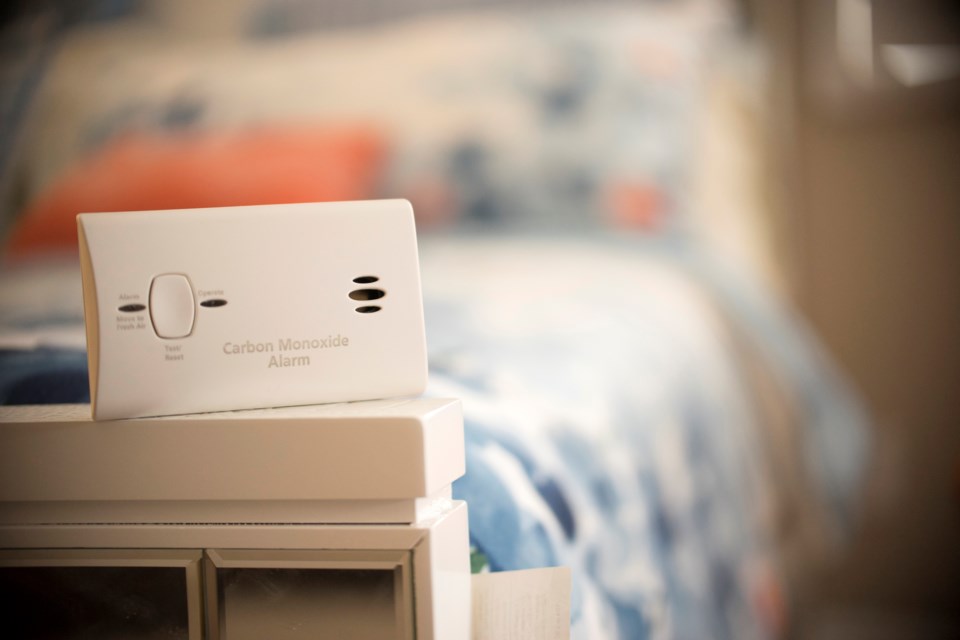Colourless. Tasteless. Odourless. Poisonous.
Carbon monoxide is known as the silent killer because it is impossible to detect without a proper alarm. When people are exposed to carbon monoxide the consequences could be serious, even lethal.
Last week B.C. celebrated its second annual Carbon Monoxide Awareness week— a week devoted to raising awareness about carbon monoxide hazards and how to keep yourself and your family safe.
Carbon monoxide risks exist in nearly every home across the province, whether you are a renter or a homeowner. Carbon monoxide is created when fuels such as propane, natural gas, oil, wood, charcoal, alcohol, kerosene or gasoline are burned incompletely.
The early signs of carbon monoxide poisoning can feel a lot like the flu, and symptoms include headaches, confusion, vomiting, weakness, dizziness, and chest pain.
This potentially lethal gas can be produced by everyday household appliances like your furnace, boiler, hot water tank, stovetop, dryer, or fireplace if they are not installed properly and maintained regularly.
Similarly to your vehicle or bicycle, gas appliances require annual maintenance to make sure they are running as safely and efficiently as possible
“Home appliances that are not installed and serviced properly can pose a serious risk to your safety,” said Ryan Milligan, Senior Safety Officer, Gas at Technical Safety BC. “If one of your appliances is creating carbon monoxide, it can build up quickly — especially in smaller places like rental units, and that build-up often has fatal consequences.”
If you rent an apartment, a condo, or a basement suite, it’s not only your right, but also your responsibility to make safety-conscious decisions. When you move into a rental suite, it is important to ask your landlord when the gas appliances were last inspected. Additionally, check with your landlord if your unit has working carbon monoxide detectors and ensure they have not expired.
“Now that we’re in heating season, it’s the perfect time for renters to ask their landlord when their gas appliances were last serviced by a licensed contractor,” says Milligan.
Carbon monoxide fatalities are a reality in British Columbia. This summer there were several cases of lethal carbon monoxide poisoning due to fuel burning appliances that were not installed or maintained by qualified professionals. These incidents occurred at off the grid properties and highlight the risks associated with DIY installation of gas appliances.
Gas Appliances. Photo provided by Technical Safety BC.
“It's important to have a licensed contractor install new gas appliances and then ensure that these appliances are serviced annually to reduce the risk of exposure to carbon monoxide,” recommended Michelle Petrusevich, Program Manager of Public Safety at FortisBC.
“Safety is always a top priority at FortisBC, and we respond to all suspected carbon monoxide calls by sending a technician who will inspect all gas appliances to determine if there is a source of carbon monoxide and, if needed, they will shut off the appliance.”
To easily find a licensed gas contractor to inspect your appliances use Technical Safety BC’s directory or FortisBC's Trade Ally Network.
When adding a carbon monoxide detector to your living space, consider the following:
-
Look for a certification mark from a certification body accredited by the Standards Council of Canada.
-
Install your carbon monoxide alarms in the hallway outside of bedrooms and on every floor of your house.
-
Take note of your carbon monoxide alarm’s replacement date. If your alarm is battery operated, check the batteries at least twice a year.
-
Conduct regular carbon monoxide alarm testing to ensure the device is functioning correctly. Replace the alarm once it has expired.
-
When the alarm sounds, always investigate - but do so safely. Although the detector can be triggered by gases or conditions other than carbon monoxide, it’s essential to determine the cause so that you can prevent a worst-case scenario.
If your alarm indicates high carbon monoxide levels in your home or you suspect carbon monoxide poisoning:
-
Open all doors and windows and get outside to fresh air immediately.
-
Seek emergency medical attention for symptoms of carbon monoxide poisoning. Symptoms include flu-like symptoms such as headaches, nausea, vomiting, dizziness, burning eyes, confusion, drowsiness and even loss of consciousness.
-
Call 9-1-1 or your local emergency number and your gas service provider’s 24-hour emergency line. Don’t go back into the building until it’s safe.
-
FortisBC: 1-800-663-9911
-
Pacific Northern Gas: 1-800-663-1173
-
-
After returning to the building have a licensed contractor inspect your gas appliances.
By equipping yourself with the information on preventing carbon monoxide exposure in your home, you can keep your household safe.
For more on how to keep your home carbon monoxide safe, see Technical Safety BC and FortisBC.
Carbon Monoxide Alarm. Photo: iStock Photo.
We’ve partnered with Technical Safety BC and FortisBC to award one lucky winner with a carbon monoxide detector for their home!
The Technical Safety BC + FortisBC Grand Prize includes:
-
1 carbon monoxide detector (Valued at $50 CAD)
Total Grand Prize Value: $50 CAD
You can enter via the contest entry form below. For additional chances to win, visit both Technical Safety BC and FortisBC on Facebook and Instagram for 25 bonus entries each and visit their websites for another 10 bonus entries.
This contest is open to British Columbia residents and closes on November 23, 2020. The contest winner will be contacted via email on this date.



